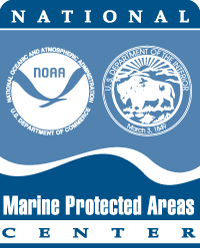Protecting Our Planet
MPA video featured on the Ocean Today Kiosk (part of Sant Ocean Hall at the Smithsonian National Museum of Natural History)
Transcript
NARRATOR:
Chances are you've visited a Marine Protected Area and didn't even know it. If you've gone fishing in central California, diving in the Florida Keys, swimming in Cape Cod, or hiking along the Olympic Coast, you've probably been one of millions of visitors to a Marine Protected Area, usually referred to as an MPA.
So what exactly are MPAs? They are defined areas established by state or federal agencies, where natural and cultural resources are given greater protection than the surrounding waters.
In the United States, MPAs span a range of habitats, including open ocean, coastal areas, intertidal zones, estuaries, and the Great Lakes. These protected areas are important because they help sustain critical habitats and marine resources. They provide recreation and economic opportunities like fishing, and they act as an insurance policy by helping to protect marine resources from human impacts.
Marine protected areas are just one type of ocean management tool that, when used effectively, helps ensure a healthy ocean for generations to come.
 Marine Protected Areas
Marine Protected Areas